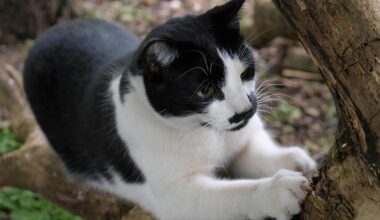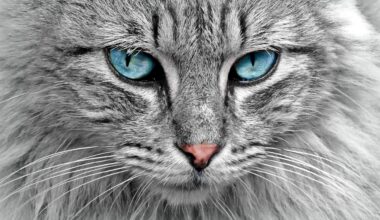How Cooking Affects Omega-3 and Omega-6 Fatty Acid Content in Cat Food
Omega-3 and Omega-6 fatty acids are crucial for a cat’s overall health and well-being. These essential fats play a significant role in maintaining healthy skin, shiny fur, and promoting optimal cognitive function. However, the cooking process can greatly influence the levels of these important nutrients in cat food. When preparing meals for cats, it is essential to understand how different cooking techniques can affect the bioavailability and potency of these fatty acids. By utilizing cooking methods that preserve omega fatty acids, pet owners can ensure that their felines receive the best nutrition possible. This article explores the effects of various cooking techniques on the omega-3 and omega-6 content in foods designed for cats, including the potential nutritional losses incurred during preparation. Being informed can guide effective meal planning and provide an edge in optimizing your pet’s diet. Thus, the focus will be on actionable tips and insights, making it critical for pet owners to be aware of best practices to maintain these nutrients in their cats’ meals while promoting their health and vitality through proper nutrition.
To better understand how cooking affects omega fatty acid content, it’s crucial to recognize the various methods used in food preparation. Different cooking methods yield different results in terms of nutrient retention. For instance, boiling, steaming, and frying can all have varying impacts on essential fatty acids. Boiling tends to lead to significant nutrient leaching into the water, while frying can alter the chemical structure of omega-3 and omega-6 acids, potentially leading to detrimental effects. Additionally, the temperature during cooking plays a key role in preserving these sensitive nutrients. Lower cooking temperatures and shorter cooking times can help retain more omega fatty acids. Certain foods are often better prepared using methods such as steaming or baking over other, more aggressive cooking techniques that may result in nutrient loss. Pet owners should consider incorporating raw or minimally processed ingredients into their cats’ diets, as this can help preserve the beneficial omega fatty acids. At the same time, a balanced diet is essential for optimal health, so it’s necessary to find the right compromise between cooking methods and retaining these valuable nutrients.
The Role of Ingredients
The types of ingredients used in preparing cat food also play a vital role in omega fatty acid content. Fish oil is a rich source of omega-3 fatty acids, while various seed oils contribute omega-6 fats. Choosing high-quality ingredients rich in these essential fatty acids can help bolster your cat’s diet immensely. Ingredients must be sourced carefully to ensure they retain their nutritional value, especially during cooking. With ingredients such as flaxseed, salmon, or other omega-rich fish, careful use of heat during preparation can maintain the integrity of these fats. In contrast, certain oils can deteriorate more readily under heat and prolonged exposure, losing their health benefits. Utilizing fresher and less processed ingredients may mitigate the risk of false nutrient marketing and improve health outcomes for your cat. Understanding the nutritional profiles of different ingredients, along with how to cook them effectively, can make a significant difference in the omega-3 and omega-6 levels in homemade cat food, thus contributing to a balanced and nourishing diet.
To maximize omega fatty acid retention, focusing on food combinations is also necessary. When creating a balanced meal for your cat, it’s essential to include sources of both omega-3 and omega-6 fatty acids. Balancing out these fats not only promotes healthy skin and coat but also contributes positively to overall health and longevity. Certain combinations of ingredients, such as pairing fish with specific vegetables or grains, can enhance the nutritional benefits. Additionally, avoiding heavily processed foods may prevent the loss of vital omega fatty acids due to manufacturing processes that can strip these nutrients away. Supplementation can also be considered; however, it’s crucial to avoid over-supplementation of omega-6 fatty acids, as excess can lead to health issues. By focusing on whole, natural, and minimally processed food options, pet owners can provide a richer nutritional profile for their felines. Understanding the synergy between different ingredients can further ensure that your cat receives an excellent balance of omega-3 and omega-6 from their meals, leading to a healthier, happier life.
The Importance of Storage
Another crucial aspect that affects omega-3 and omega-6 fatty acids in cat food is proper storage. Fatty acids are sensitive to light, heat, and oxidation, leading to their degradation over time. Therefore, once opened, oil bottles or other fatty acid-rich products should be stored in a cool, dark place. Using opaque containers can also help minimize light exposure and protect the beneficial fats. For homemade cat food that contains omega-3 and omega-6 sources, careful storage is essential to ensure these nutrients do not diminish before they reach your cat’s bowl. Understanding shelf life, proper sealing, and refrigerating practices can play a significant role in maintaining nutrient content. Buying only what is necessary and rotating stock regularly can also help in preserving omega fatty acids. By paying special attention to storage practices, pet owners can vastly improve the nutritional profile of omega-rich ingredients in their cats’ diets, thus supporting their overall health.
Another thing to consider is the possibility of supplementing with omega fatty acids if home cooking proves too complex or time-consuming. High-quality fish oil or algae-based omega-3 supplements can be administered directly to your cat or blended into their food. Such supplements provide concentrated sources of the essential fats that might sometimes be challenging to achieve through diet alone. However, choosing the right supplement is vital; always consult your veterinarian before introducing any additional products to your cat’s diet. Pet owners must ensure that supplements are safe and effective while monitoring for any adverse reactions, particularly if their cat has dietary restrictions or health conditions. Furthermore, the choice of a supplement must be consistent with the optimal fatty acid ratio for felines, promoting heart health and reducing inflammation without overloading them on omega-6s. A well-researched supplementation strategy can help support your cat’s ongoing wellness when formulated to complement their primary diet.
Conclusion: Prioritizing Omega Fatty Acids
In conclusion, understanding how cooking affects omega-3 and omega-6 fatty acids in cat food is crucial for any pet owner. The right techniques, ingredient choices, and storage methods can positively influence your cat’s health and well-being through nutrition. With various cooking methods available, knowing which ones suit omega fatty acid retention is paramount. Combining ingredients, considering supplementation, and practicing good storage techniques are significant steps in maintaining these essential fatty acids. Ultimately, prioritizing omega fatty acids in your cat’s diet can yield significant benefits, promoting longevity, vitality, and energy. By being diligent in your food preparation and making informed choices, you can craft a diet that maximizes the health benefits of omega-3 and omega-6 fatty acids. By understanding the complete picture, pet owners can confidently navigate the nutritional needs of their furry friends. A well-informed approach will ensure happy cats that thrive in health and happiness for many years to come.


